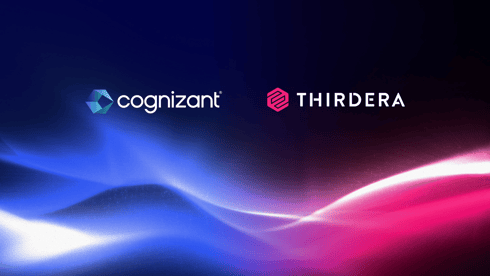Financial services, meet the future with...
Banks, credit unions, investment firms, and brokerages have relied on AI-driven tools for a longer period of time that almost any other business sector. It makes sense—large...
Read MoreThirdera generates transformation, digitization, and automation for our customers at the speed of NOW.
We help organizations adopt better patterns of work and get more from ServiceNow. Our team unlocks enterprise potential to elevate experiences across the world of work.
We help organizations adopt better patterns of work and get more from ServiceNow. Our team unlocks enterprise potential to elevate experiences across the world of work.

Exciting news! Thirdera and Cognizant Awarded Three ServiceNow Partner Specializations
Read more.jpg?width=500&height=276&name=filter%20group%20of%20people%20at%20desk%20laptop%20laughing%202021-10%20(1).jpg)


Insurance Provider Projects $75MM Gain in Business Value from Asset Management Transformation
Read more-1.jpeg?width=500&height=276&name=Indiana%20Department%20of%20Transportation%20Case%20Study%202023-03%20(3)-1.jpeg)
Government Agency INDOT Modernizes Its Constituent Service Model with CitizenKey
Read more.jpg?width=500&height=276&name=Multichannel%20pipette%20tips%20reaction%20mixture%20plastic%20wells%202022-05%20(1).jpg)

Balancing mission-driven goals with operational efficiency requires innovative solutions that can streamline processes, and enhance program delivery without straining budgets.

UN Agencies Rely on Thirdera and ServiceNow to Support the Ukrainian Aid Response
Read moreDigitize and automate workflows to enhance the customer experience, online and in-store.

.jpg?width=500&height=276&name=Servers%20data%20center%20room%20with%20bright%20speed%20light%202022-05%20(3).jpg)
Global SAP on Cloud Leader, Lemongrass, Embarks on Multi-Continent ITSM Overhaul
Read more

Stay up to date with the insights from ServiceNow experts and explore our blogs, news, case studies culture posts, partner updates and more.
Stay up to date with the insights from ServiceNow experts and explore our blogs, news, case studies culture posts, partner updates and more.


One of the most exciting advancements with AI is the shift toward Agentic AI—AI that not only responds to user inputs but takes proactive actions to achieve a goal. Unlike traditional AI, which primarily reacts to prompts, Agentic AI is designed to understand intent, make decisions, and execute tasks with minimal human intervention.
Within the ServiceNow ecosystem, this shift unlocks new possibilities for improving self-service, automating complex workflows, and enhancing overall employee and customer experiences. This is especially critical in industries like healthcare, where employees need reliable, fast, and intelligent automation to deliver patient care efficiently.
At the core of Agentic AI are AI Skills, modular capabilities that allow AI-driven systems to understand requests, retrieve relevant data, and execute tasks efficiently. Just earlier this month, we launched two AI Skills on the ServiceNow Store: 1) SAM Renewal Agent and 2) CMDB AI Advisor.
In ServiceNow, AI Skills power virtual agents, AI search, and automation to streamline interactions across IT, HR, and customer service functions. However, the success of these technologies hinges on user experience - how intuitive, trustworthy, and efficient the system feels to end users.
Users don’t just want automation - they want clarity, control, and confidence in AI-driven interactions. Poorly designed AI experiences can lead to frustration, distrust, and increased reliance on human agents, ultimately defeating the purpose of automation. To maximize adoption and trust, organizations leveraging Agentic AI within ServiceNow should focus on:
Meet David, a nurse in a busy hospital. Mid-shift, he realizes that a critical piece of medical equipment—the IV pump in his patient’s room—is malfunctioning. In the past, this would have required him to step away from his patient, call IT or clinical engineering, and wait for assistance.
With Agentic AI and AI Skills embedded in ServiceNow, David uses his hospital’s mobile app to report the issue. Instead of simply logging a ticket, the AI:
David doesn’t waste time navigating complex processes—the AI assists proactively, efficiently, and transparently. He can trust that his issue is being handled, allowing him to stay focused on patient care.
For many, AI still feels like a black box, making it difficult to trust and adopt new AI-driven solutions. However, just like any technology, the more familiar you become with it, the more comfortable you’ll feel using it. Here are a few ways to gain confidence in Agentic AI:
Explore AI-driven self-service tools in your workplace. Many companies already use AI-powered virtual agents—try engaging with them and noting how they handle requests.
Look for transparency features in AI tools. Good AI design ensures users understand how decisions are made. If a tool explains why it suggests certain actions, that’s a sign of a trustworthy AI experience.
Test AI systems in low-risk scenarios before relying on them for critical tasks. For example, if your ServiceNow platform offers AI-powered knowledge search, use it for simple inquiries and evaluate how well it meets your needs.
Stay informed about AI advancements through training sessions, webinars, and blogs. Our AI and Future of Work page is constantly updated with fresh perspectives, videos, case studies, and insights from our AI experts.
AI should feel like a helpful assistant, not a mysterious force. By gradually integrating AI into daily workflows and understanding its capabilities, users can build trust and confidence in these intelligent systems.
Agentic AI and AI Skills have the power to transform workplace experiences by reducing friction, automating repetitive tasks, and enhancing trust through clear, user-centric design. In industries like healthcare, where speed and reliability are critical, AI must be proactive, transparent, and intuitive to support employees effectively.
By prioritizing user experience, organizations can ensure that AI is adopted, trusted, and used to its full potential—helping employees like David spend less time navigating processes and more time focusing on what truly matters.
Learn more about the differences between Agentic AI, GenAI, and Legacy AI in this blog: ServiceNow Agentic AI: Transforming Workflows and User Experiences.
Banks, credit unions, investment firms, and brokerages have relied on AI-driven tools for a longer period of time that almost any other business sector. It makes sense—large...
Read MoreGrouping all patient care-related businesses under "the healthcare industry" is as oversimplified as describing our work as "something with AI." Thirdera, a Cognizant company,...
Read MoreThis global enterprise sought to modernize their 14-year-old ServiceNow instance, hampered by excessive customization, to improve service desk operations and virtual agent...
Read MoreThe ServiceNow Yokohama release became generally available on March 12, 2025, revolutionizing the NOW Platform with transformative enterprise AI capabilities. This release unifies...
Read More